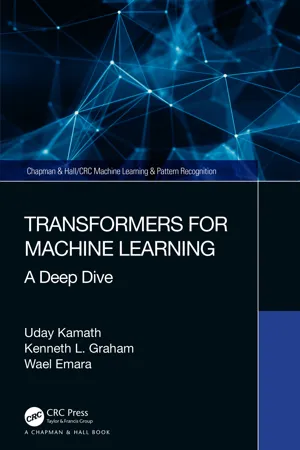
Transformers for Machine Learning
A Deep Dive
- 257 pages
- English
- ePUB (mobile friendly)
- Available on iOS & Android
Transformers for Machine Learning
A Deep Dive
About this book
Transformers are becoming a core part of many neural network architectures, employed in a wide range of applications such as NLP, Speech Recognition, Time Series, and Computer Vision. Transformers have gone through many adaptations and alterations, resulting in newer techniques and methods. Transformers for Machine Learning: A Deep Dive is the first comprehensive book on transformers.
Key Features:
- A comprehensive reference book for detailed explanations for every algorithm and techniques related to the transformers.
- 60+ transformer architectures covered in a comprehensive manner.
- A book for understanding how to apply the transformer techniques in speech, text, time series, and computer vision.
- Practical tips and tricks for each architecture and how to use it in the real world.
- Hands-on case studies and code snippets for theory and practical real-world analysis using the tools and libraries, all ready to run in Google Colab.
The theoretical explanations of the state-of-the-art transformer architectures will appeal to postgraduate students and researchers (academic and industry) as it will provide a single entry point with deep discussions of a quickly moving field. The practical hands-on case studies and code will appeal to undergraduate students, practitioners, and professionals as it allows for quick experimentation and lowers the barrier to entry into the field.
Frequently asked questions
- Essential is ideal for learners and professionals who enjoy exploring a wide range of subjects. Access the Essential Library with 800,000+ trusted titles and best-sellers across business, personal growth, and the humanities. Includes unlimited reading time and Standard Read Aloud voice.
- Complete: Perfect for advanced learners and researchers needing full, unrestricted access. Unlock 1.4M+ books across hundreds of subjects, including academic and specialized titles. The Complete Plan also includes advanced features like Premium Read Aloud and Research Assistant.
Please note we cannot support devices running on iOS 13 and Android 7 or earlier. Learn more about using the app.
Information
CHAPTER 1Deep Learning and Transformers: An Introduction
1.1 Deep Learning: A Historic Perspective
Table of contents
- Cover Page
- Half-Title Page
- Series Page
- Title Page
- Copyright Page
- Dedication Page
- Contents
- Foreword
- Preface
- Authors
- Contributors
- Chapter 1 Deep Learning and Transformers: An Introduction
- Chapter 2 Transformers: Basics and Introduction
- Chapter 3 Bidirectional Encoder Representations from Transformers (BERT)
- Chapter 4 Multilingual Transformer Architectures
- Chapter 5 Transformer Modifications
- Chapter 6 Pre-trained and Application-Specific Transformers
- Chapter 7 Interpretability and Explainability Techniques for Transformers
- Bibliography
- Index